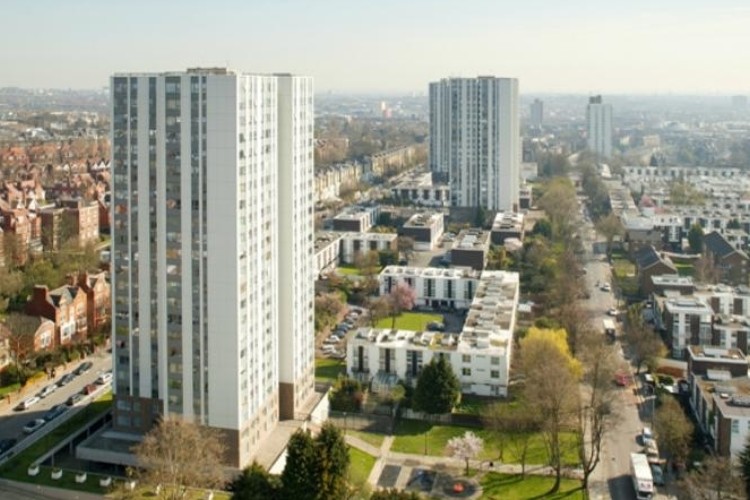The council said that it was not same cladding that was used in the recent refurbishment of Grenfell Tower, which is being blamed for exacerbating the spread of flames there, but it was still below the standards it expects.
Tower block rainscreen cladding across the country is being tested this week. According to Downing Street lobby briefings, 11 samples have so far been found to be combustible and as many as 600 are thought to have possible issues. More than 100 buildings a day are being tested.
The five Camden tower blocks to be stripped are on the Chalcots Estate, whose cladding was tested by the Building Research Establishment in response to the Grenfell fire, which killed at least 79 people.
Main contractor Rydon and subcontractor Harley Facades were responsible for recent refurbishments at both Grenfell Tower in the neighbouring Borough of Kensington & Chelsea and the £66m Chalcots Estates makeover in Camden, which it completed in 2009.
Councillor Georgia Gould, leader of Camden Council, said: “Following last week’s tragic fire at Grenfell Tower, Camden Council immediately reviewed fire safety at all our high rise blocks. We knew we had set the highest standards but we weren’t prepared to take anything for granted and we were first in the queue to test the cladding on our blocks.
“We have now received the results of independent testing of cladding on Chalcots Estate from the laboratory at the Building Research Establishment.
“The arrangement of the cladding and insulation used on Camden Council’s buildings significantly differs from that on Grenfell Tower. It includes fire-resistant rock wool insulation designed to prevent the spread of fire and fire resistant sealant between floors, designed to stop a high-intensity flat fire from spreading to neighbouring flats. This arrangement previously contained a fire at a flat in Taplow block in 2012. These are significant and proven arrangements to stop the spread of fire.
“The new results from the laboratory show that the outer cladding panels themselves are made up of aluminium panels with a polyethylene core.
“Therefore the panels that were fitted were not to the standard that we had commissioned. In light of this, we will be informing the contractor that we will be taking urgent legal advice.

“Whilst we are clear that our cladding design and insulation significantly differs to that at Grenfell Tower, the external cladding panels did not satisfy our independent laboratory testing or the high standards we set for contractors. Camden Council has decided it will immediately begin preparing to remove these external cladding panels from the five tower blocks on the Chalcots Estate. Camden Council will do whatever it takes to ensure our residents are reassured about the safety of their homes.
“Until the panels have all been removed, we will carry out 24/7 fire safety patrols on the estate’s corridors to reassure residents and carry out enhanced fire safety checks. This additional assessment work includes a sweep of corridors to make sure they are clear of obstructions and anything that is potentially flammable. We will also be working with residents to test white goods (PAT testing), assessing fire doors in properties and we will be providing fire safety advice to residents.
“We have set up an information point on Chalcots Estate staffed by our housing teams who will be highly visible to our residents over the coming days. We want any residents who have concerns or questions to come to the information point so we can help them.
“We are working side-by-side with our housing groups and the London Fire Brigade and we remain ready to respond to any changes to national fire safety advice. We stand ready to fully support any national investigation into materials, building standards and safety regulations.
“It’s vital for all of London’s residents who live in high-rise buildings, that we learn from investigations into what caused and exacerbated the tragic fire at Grenfell Tower.”
Camden New Journal has obtained a statement from Ray Bailey, managing director at Harley Facades saying that the cladding panels used on the Chalcots were actually the same Reynobond type that were used on Grenfell Tower, and he said that they were approved by Camden Council as meeting the specification. Other reports suggest the insulation between cladding and building structure were different though.
“These works were as described in the contractual specification and approved in the usual process for construction and building control by the London Borough of Camden,” Mr Bailey said.
“All major construction projects are subject to a local authority on-site inspection process where inspectors will have to review the works and check whether the building is in line with the plans and specifications.”
He also said: “There is no evidence to suggest that this product and cladding system installed in Camden is unsafe. Currently there is no link between the cladding and the spread of the fire at Grenfell Tower. It is right that questions are asked and there will be many questions about this whole tragic incident.”
Got a story? Email news@theconstructionindex.co.uk



